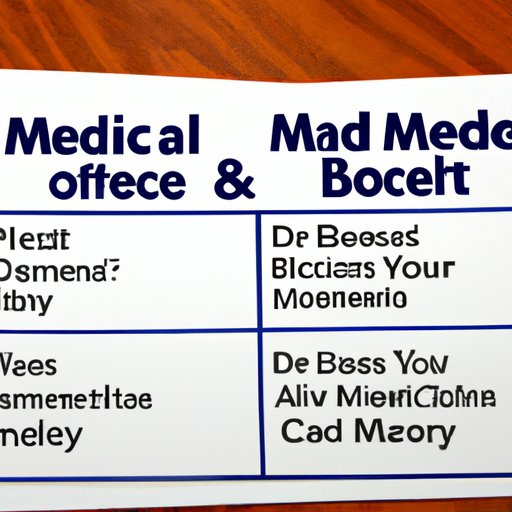Introduction
Medicare is a federal health insurance program that provides coverage to millions of Americans aged 65 and older, as well as some younger individuals with certain disabilities or illnesses. The program offers a variety of benefits and coverage options for those who qualify, and understanding these benefits can be essential for making informed decisions about your health care options. In this article, we will explore the different parts of Medicare and what they cover, how Medicare benefits compare to other health insurance options, how it covers prescription drugs and home health care services, and how it can help cover long-term care costs. We will also compare Medicare Advantage plans to original Medicare and explore supplemental insurance options for Medicare beneficiaries.
Explaining the Different Parts of Medicare and What They Cover
Medicare is divided into four parts – Part A, Part B, Part C, and Part D. Each part covers different types of medical care and services.
Part A: Hospital Insurance
Part A, also known as hospital insurance, helps pay for inpatient care in hospitals, skilled nursing facilities, hospice care, and some home health care services. This part of Medicare does not cover doctor’s visits, outpatient care, or other medical services.
Part B: Medical Insurance
Part B, also known as medical insurance, helps cover doctor’s visits, outpatient care, preventive services, and durable medical equipment, such as wheelchairs and walkers. Part B also helps cover certain laboratory tests and screenings, as well as mental health services.
Part C: Medicare Advantage Plans
Part C, also known as Medicare Advantage plans, are offered by private insurance companies and provide an alternative way to receive your Medicare benefits. These plans typically offer additional coverage, such as vision and dental, and may have lower out-of-pocket costs than Original Medicare. However, there may be restrictions on which doctors and hospitals you can use with these plans.
Part D: Prescription Drug Coverage
Part D, also known as prescription drug coverage, helps cover the cost of prescription drugs. This part of Medicare is offered through private insurance companies and may also include coverage for generic drugs and some brand-name drugs.

Analyzing How Medicare Benefits Compare to Other Health Insurance Options
When considering health insurance options, it is important to understand the coverage limits and cost considerations associated with each plan. Medicare offers comprehensive coverage for most medical expenses, but there are some limitations. For example, Medicare does not cover cosmetic surgery, routine physical exams, hearing aids, or eyeglasses.
Coverage Limits
In addition to the coverage limits described above, Medicare also has limits on the amount it will pay for certain services. For example, Medicare will only pay 80% of the cost of covered services after you meet your deductible. You may need to purchase supplemental insurance to cover the remaining 20%.
Cost Considerations
The cost of Medicare coverage varies depending on your income and other factors. Most people pay a monthly premium for Part B, and some may also pay a premium for Part D. In addition, there may be deductibles and copayments for certain services, and you may be responsible for 20% of the cost of covered services after you meet your deductible.

Examining How Medicare Covers Prescription Drugs
Prescription drugs can be expensive, and Medicare offers several options to help cover the cost of medications. Here are some of the ways Medicare can help.
Medicare Part D
Medicare Part D is a stand-alone prescription drug plan that is offered by private insurance companies. This plan helps cover the cost of prescription drugs, including generic and some brand-name drugs. Depending on your plan, you may have to pay a monthly premium, a deductible, and copayments for your prescriptions.
Medicare Part B
Medicare Part B helps cover the cost of certain medications that are administered in a doctor’s office or hospital, such as chemotherapy or intravenous drugs. You may have to pay a copayment for these medications.
Costs of Prescription Drugs
The cost of prescription drugs can vary significantly depending on the type and dosage of the medication. There are resources available to help you find the lowest cost options for your medications, such as discount programs and online pharmacies.
Describing How Medicare Covers Home Health Care Services
Medicare can help cover the cost of certain home health care services, such as nursing care, physical therapy, and occupational therapy. Here is what you need to know.
Eligibility Requirements
To be eligible for Medicare home health care services, you must be under the care of a doctor, have a face-to-face encounter with a doctor or nurse practitioner within the last 90 days, and be receiving services from a Medicare-certified home health agency.
Coverage Limits
Medicare will cover up to 80% of the cost of home health care services after you meet your deductible. You may need to purchase supplemental insurance to cover the remaining 20%. Medicare also has limits on the number of visits it will cover and the types of services it will cover.
Costs
The cost of home health care services can vary depending on the type and frequency of services needed. Medicare-certified home health agencies must accept Medicare payment as payment in full, so you may not have any out-of-pocket costs.
Analyzing How Medicare Can Help Cover Long-term Care Costs
Long-term care can be expensive, and Medicare can help cover some of the costs. Here are some of the ways Medicare can help.
Skilled Nursing Facility Care
Medicare Part A covers up to 100 days of skilled nursing facility care after a three-day hospital stay. This benefit helps cover the cost of nursing care, therapy, and other services provided in a skilled nursing facility. You may have to pay a portion of the costs.
Home Health Care
Medicare Part A also covers home health care services, such as nursing care, physical therapy, and occupational therapy. These services must be ordered by a doctor and provided by a Medicare-certified home health agency.
Hospice Care
Medicare Part A covers hospice care for individuals who have a terminal illness and have elected to forego curative treatment. Hospice care includes pain relief, symptom management, and emotional and spiritual support for the individual and their family.

Comparing Medicare Advantage Plans to Original Medicare
Medicare Advantage plans are offered by private insurance companies and provide an alternative way to receive your Medicare benefits. These plans typically offer additional coverage, such as vision and dental, and may have lower out-of-pocket costs than Original Medicare. Here are some things to consider when comparing these plans.
Coverage Benefits
Medicare Advantage plans may offer additional coverage benefits, such as vision and dental, that are not included in Original Medicare. These plans may also have lower copayments and coinsurance than Original Medicare. However, there may be restrictions on which doctors and hospitals you can use with these plans.
Costs
Medicare Advantage plans may have lower out-of-pocket costs than Original Medicare, but they may also have higher monthly premiums. It is important to compare the costs of each plan to determine which one is best for you.
Exploring Supplemental Insurance Options for Medicare Beneficiaries
Supplemental insurance can help cover the costs that Medicare does not, such as copayments and coinsurance. Here are some of the options available.
Medigap Insurance
Medigap insurance is sold by private insurance companies and helps cover the gaps in Original Medicare. These policies help pay for out-of-pocket expenses, such as copayments and coinsurance. Medigap plans are standardized and must follow certain rules set by the government.
Employer Sponsored Insurance
If you are still working, your employer may offer health insurance coverage that supplements Medicare. These plans may cover some of the costs that Medicare does not, such as copayments and coinsurance.
Medicaid
Medicaid is a state and federal program that provides health coverage for low-income individuals and families. Medicaid may help cover the costs that Medicare does not, such as long-term care and prescription drugs.
Conclusion
Medicare is a federal health insurance program that provides coverage to millions of Americans aged 65 and older, as well as some younger individuals with certain disabilities or illnesses. The program offers a variety of benefits and coverage options, including hospital insurance, medical insurance, prescription drug coverage, and home health care services. Medicare also helps cover long-term care costs, such as skilled nursing facility care, home health care, and hospice care. In addition, there are supplemental insurance options available to help cover the costs that Medicare does not, such as Medigap insurance, employer sponsored insurance, and Medicaid. Understanding these benefits can be essential for making informed decisions about your health care options.
(Note: Is this article not meeting your expectations? Do you have knowledge or insights to share? Unlock new opportunities and expand your reach by joining our authors team. Click Registration to join us and share your expertise with our readers.)
